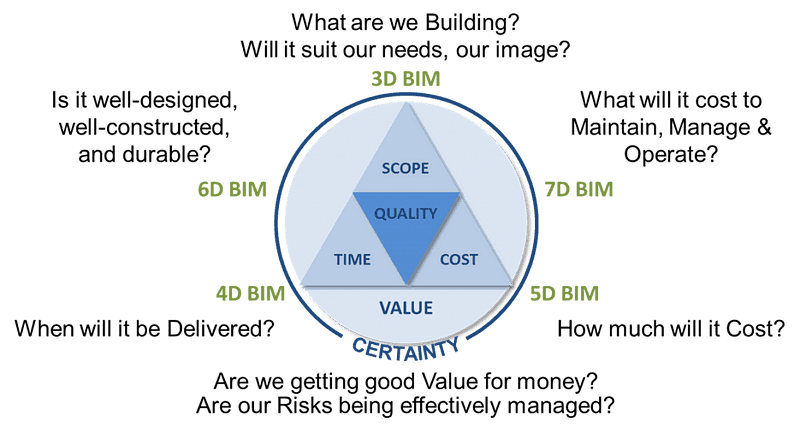In this article, we will explore the things we need to know about building information modeling (BIM) in relation to construction project management — why is BIM important to project management, what is the role of the construction project manager in the BIM process and how will BIM and BIM-related tools change construction project management?
The construction project manager plays a huge part in achieving a project’s building objectives, delivering high quality projects on time and within budget, making the worksite accident free as much as possible, optimising project lifecycle cost, and reducing the project’s environmental impact. Technology processes and tools like BIM target all these things with the added benefit of better stakeholder engagement.
The construction project manager is involved from the get-go so as to execute project control procedures that will shape the direction of the building project and the project team. Studies have shown over and over again that 36% of construction projects fail to deliver on their initial KPIs (key performance indicators). The reason for this statistical failure is attributed to poor communication, information, or focus. Using BIM as your company’s communication tool will benefit you in all aspects related to these low productivity issues.
However, to include BIM in your methods, is a decision that must be specified the earliest time possible and must be monitored from then on. Construction project managers need not be BIM experts but should understand their role in the BIM process and recognise when to solicit expert advise and procure the correct expertise.
Do you need BIM in your projects?
In the aspect of construction project management, BIM can be utilised to control the scope, time, cost, quality, safety, and sustainability of your project. This ensures that project risks are calculated and can be managed. In so doing, the client gets value for his money.
A few studies have suggested that BIM and digitalisation result to remarkable cost savings, for example 13–21% savings in the design, engineering and construction phases, and 10–17% in the operations phase. With all the infamous productivity problems in construction and the potential solutions that BIM and BIM-related tools can offer, it would just be logical to use it to get ahead.
When deciding to use BIM in your project, first thing to consider would be the long-term need for capturing digital data that will be beneficial for carrying out efficiencies in the operational phase. Do you realise the overall benefit in requiring both design and build teams to manage all data from drawings to schedules to specifications, etc. using a digital BIM process that complies to industry standards?
Do you value data over paperwork? If you answered yes to these two questions, then BIM would be an effective and efficient option for you in generating and managing information and communicating said information to your team, shareholders and even future building occupants. BIM will reduce risks, miscommunications, delays, disputes, and time and cost overruns. BIM will give you high quality digital data that is accurate and accessible at anytime. By the end of the construction phase, your digital data can be used for facilities management and future construction projects.
Would you like to read about the history of BIM in a nutshell or how about a detailed explanation of BIM’s benefits to construction? Don’t be shy and click the links!
Assessing your team’s BIM capability
After establishing the benefits of BIM, next thing to consider would be your project team’s capability to use it. From there, you select members for your prospective BIM team and assess their capabilities to use BIM or their willingness to acquire the required capabilities.
During this pre-qualification stage, there are four simple questions you need to ask pertaining to generic BIM policies and capabilities (as derived from Publicly Available Specification 91 — PAS 91):
- Do you have the capability of working with a project using a “Common Data Environment”?
- Do you have documented policy, systems and procedures to achieve “Level 2 BIM” maturity as defined.
- Do you have the capability of developing and delivering or working to (depending upon the role) a BIM Execution Plan (BEP)?
- Do you have arrangements for training employees in BIM related skills and do you assess their capabilities?
Before any prospective member or supplier is appointed, the construction project manager should get them to answer an individual BIM capability assessment — which includes their personal assessment of your company’s IT infrastructure and human resources. These assessments will be compiled and summarised into your Project Implementation Plan (PIP).
BIM should be a contractual obligation
If your company decides to use BIM, it should be made as a contractual obligation for all stakeholders and project members. If not made into a contractual requirement, some parties may avoid or stop using it which will ruin BIM engagement for everyone.
For example, in the UK, the Construction Industry Council developed a standard BIM protocol, which is, basically, a supplementary legal agreement detailing contractual documentation, defined obligations, liabilities and limitations on the use of BIM. This legal agreement should be attached to all your contracts and appointments.
Information management and the construction project manager
It’s the project manager who makes sure that there is a person in charge for each type of information being generated then he coordinates all these information into a Common Data Environment (CDE). For example, the project manager will appoint an architect or lead designer to be the information manager for the design stage, and the main contractor will be in charge of information in the construction stage. Then the project manager would be maintaining the CDE which will be used by all parties to share and manage all the documents and data of the project.
The BIM execution plan
Additionally, the project manager makes sure that there is a BIM Execution Plan (BEP) that addresses the Employers Information Requirements (EIR). The project team is then expected to follow the BEP and deliver required information accordingly — it is the project manager’s job to track that the BEP is being followed.
The future of construction project management

Image taken from BIM Ireland.
Obviously, BIM and BIM-related technology are powerful tools for curbing the most common problems in construction and project delivery. As the industry becomes even more competitive, the use of BIM in construction project management would be inevitable as it would give the edge to delivering high quality projects on time. Maybe it’s time you should rethink your processes.
For a more thorough discourse on the future of BIM, read our supplementary article. We also have a downloadable ebook that discusses other aspects of improving your worksite productivity. Download The Circle of Productivity now!




